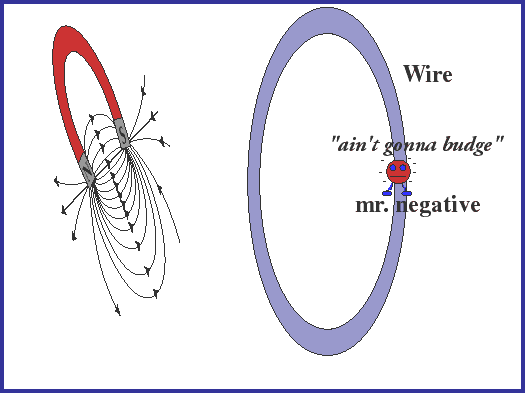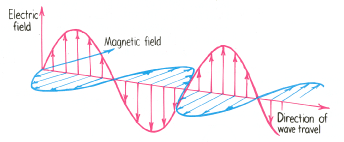![]()
![]()
___A magnet will attract a paper clip:
a) when the paper clip has a net charge.
b) only when the paper clip is already magnetized.
c) when the paper clip is made of a material that conducts electricity well.
d) when the paper clip can temporarily become a magnet.
e) when electron spins in the paper clip can cause current to flow.
![]()
When speaking of macroscopic objects in motion, we defined Power as work done per unit time (units of energy in J (joules) per time (seconds). A joule per second is a watt (W).
Recall that voltage is energy/charge (units joules/coulomb) and that current is charge moving over time (units are coulombs/second). Thus voltage times current, V x I, is energy per time, or power:
Some of the power supplied to any circuit is lost as "heat," the increase in average kinetic energy of atoms and molecules of metals, air, water, pins hit by marbles, etc. In electrical circuits this process is known as "Joule heating," named after James Prescott Joule. Using Ohm's law to substitute for voltage, one can see that power is given by:
Fuses exploit this principle. If a "short" occurs in a circuit, a path for electricity to flow that has too little resistance, then current will increase through the entire circuit. As long as the fuse has the least tolerance for heat, the increased current will heat the element of the fuse until, eventually, it will melt, breaking the circuit.
![]()
Consider an analogy to a battery... a mass on a table.
This particular table can also lift the mass from its base to its top.... giving the mass gravitational potential energy (the potential for gravity to do work on the mass if it falls). So this special table is analogous to a battery, and the mass is like a charge that is pushed through a connected circuit by the "charge push" of the battery.
What's involved in hooking up two batteries in parallel?
Using our table analogy, we simply slide in another table, with its own mass, next to the first. The second table can do work on its own mass, but it can't do work on the mass on the first table. The second table's mass, when dropped, will have no more energy than the mass dropped from the first table. The "charge push" (voltage) will not change when the second "battery" is wired in parallel to the first.
How do we rig up our tables to represent two batteries in series. We stack the second table on the first. The first takes its mass and lifts it to the top. The second special table lifts the mass up even higher. Now, when the mass is dropped, more work can be done on it (as evinced by the higher speed it attains in falling twice the original distance). So the "charge push" (voltage) is doubled!
![]()
![]()
Magnetism
Why can magnets pick up nails and paper clips?

During the last lecture we considered how a charged balloon sticks to a wall. This phenomenon was called "polarization."
- Note that the wall doesn't have to be charged for the charged balloon to stick to it.
- Also note that the force owing to polarization between a charged and uncharged object is always attractive.
- Finally, note that the magnetic force between nails, paper clips, etc., and magnets is also always attractive.
So what happens when a magnet is brought near a paper clip?
It turns out that magnetism can be explained by moving charges. In particular, the electrons moving about the nucleii of atoms give rise to magnetism.
- We can use our electrophorous to demonstrate that moving charges create magnetic fields.
Electrons have charge, and when they are in motion within atoms-- either in "orbits" moving around nucleii, or because of electron "spin" (akin to them spinning on an axis), they create magnetic fields. (Magnetic "fields" are a convenient way to describe magnetism.)
The most common kind of magnetism, called ferromagnetism, occurs when the magnetic fields in atoms of certain kinds of metals (e.g., iron, nickel) align strongly. Think of a bunch of tiny bar magnets balanced on sticks so they can spin easily. The magnetic field of one of the tiny magnets affects others nearby, causing them to spin and align with it. This normally occurs in clusters of adjacent atoms called domains. Even unmagnetized chunks of iron have domains.
Examination of the domains of a chunk of unmagnetized iron would show that the fields of the domains are randomly aligned with respect to one another. If we denote each domains field with an arrow, here is what this might look like:
We now know that, in ferromagnetic materials, a external magnetic field (surrounding, say, a permanent magnet) will affect the domains of the nails and paper clips. The effect of domain alignment causes the nail or paper clip to become temporarily magnetized, and it will be attracted to the permanent magnet.
What are those funny lines scientists are always drawing around magnets? What are they about?
Magnetic field lines are a way to show the direction and strength of magnetic forces. The direction of the field line shows the direction of push or pull that a magnetized particle would have. The density of field lines indicates the strength of the field.
Christian Orsted observed in 1819 that a wire carrying a current (charge in motion) produces a magnetic field. This is how electromagnets work- current flows through a coil of wire, the optimal arrangement of wire for producing a strong magnetic field. One can observe current producing a magnetic field by placing a compass next to a wire carrying current:
One can reinforce the current-carrying wires magnetic field by winding it into a coil. This gives a stronger magnetic field. The field lines from this coil resemble those of a bar magnet.
This is perhaps better demonstrated with the fabulous jumping wire demonstration.
Electric Motors
Magnets can exert forces on one another. One can construct a permanent magnet as shown below. The magnetic field lines connect the magnet's "south" pole to its north.
Now place a current-carrying coil of wire so that its magnetic field interacts with the permanent magnet. In general, the fields of the two magnets (permanent and coil) will try to line up with one's south pole near the other's north (and vice versa).
If we did nothing else to our prototype electric motor, it would NOT WORK! What keeps our motor spinning? We use a special switch, called a commutator, and brushes to reverse the direction of the coil's magnetic field every half-turn. Once the coil's south pole is near the permanent magnet's north, we switch the direction of the current through the coil. This reverses the coil's magnetic field. Now the coil's north field is near north of the permanent magnet, so they repel. This keeps the coil rotating.
Thus we build our motor. Things that control the useful power we get out of an electric motor are:
- number of windings in coil/armature, more windings give a stronger magnetic field.
- (magnetic field) strength of permanent magnets.
- area of the coil (larger area results in a stronger field.
- multiple coils inside motor.

Electromagnetic Induction
- If moving (e.g., spinning or orbiting) charge results in magnetism, can a magnet be manipulated to move charge? Let's look at the Lenz's Law demonstration.

- It appears that a changing magnetic field can cause charge to move. More specifically, the changing magnetic field creates a voltage (charge push) which can cause current to flow. We can have that electric current flow through a circuit and do useful work for us.
- Let's spend a few minutes discussing the particulars of how this happens, and comparing motors to generators.
- A changing magnetic field is shown to induce charge to move along a wire. What if the wire is taken away? What is left?
- Even without the wire, a changing electric field still remains. How do we know this? Put the wire back in and the changing electric field will push or pull charges along it. Faraday's law describes this phenomenon:
- An electric field is induced in any region of space in which a magnetic field is changing with time. The magnitude of the induced electric field is proportional to the rate at which the magnetic field changes (faster change gives stronger electric field). The direction of the induced electric field is at right angles (perpendicular) to the changing magnetic field. (shamelessly stolen from Conceptual Physics, by Hewitt)
- The charge moving along the wire was shown to create another magnetic field (remember when the wire jumped out from between the magnets?). If the moving charge changed (current varied), the magnetic field it generated also varied. What happens when we take away the wire? The varying electric field creates a varying magnetic field! This is one of Maxwell's laws:
- A magnetic field is induced in any region of space in which an electric field is changing with time. The magnitude of the induced magnetic field is proportional to the rate at which the electric field changes. The direction of the induced magnetic field is at right angles to the changing electric field. (ditto)
- And now we're back to square one. The changing magnetic field induces a changing electric field, which in turn induces a changing magnetic field. This is the way light, radio, x-rays, micro, ultraviolet and infrared waves travel through empty space!

![]()